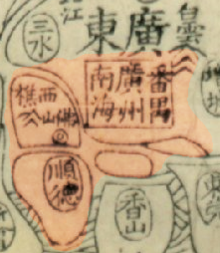Sanyi
Appearance
| Sanyi | |||||||||||||
|---|---|---|---|---|---|---|---|---|---|---|---|---|---|
 Detail of a 1797 map, with added highlighting on the Guangzhou area, including the Sanyi[1] | |||||||||||||
| Chinese | 三邑 | ||||||||||||
| Literal meaning | three counties | ||||||||||||
| |||||||||||||
| Alternative Chinese name | |||||||||||||
| Traditional Chinese | 南番順 | ||||||||||||
| Simplified Chinese | 南番顺 | ||||||||||||
| Literal meaning | Nanhai Panyu Shunde | ||||||||||||
| |||||||||||||
The Sanyi, Three Counties, or Nanpanshun also known by various Cantonese romanizations such as Sam Yup and Nam Pun Shun refers to the three former counties of Nanhai, Panyu, and Shunde surrounding Guangzhou and Foshan.
Geography
The former counties and the corresponding modern districts are
- Nanhai
- modern Nanhai and Chancheng in Foshan, and a small part of Liwan in Guangzhou
- Panyu
- modern Panyu, Yuexiu, large part of Liwan, Haizhu, Huangpu, Baiyun, and large part of Nansha, all in Guangzhou
- Shunde
- modern Shunde, Foshan
Dialects
The area gave rise to the Yuehai dialects, the most prominent of which is Cantonese (Guangzhou/Guangfu dialect). Standard Cantonese is base on the Yuehai dialects belong to the Yue branch of Chinese, Cantonese speakers easily understand throughout Chinese part of Lingnan area.
Emigration
Many of the Chinese immigrants to the United States in the late 19th century came from this part of the Pearl River Delta, together with the coastal region of Siyi to the southwest.[2][3]
References
- ^ Jing ban tian wen quan tu, by Ma Junliang, 1797. (Library of Congress)
- ^ Lai, Him Mark (2004). "The Sanyi (Sam Yup) community in America". On Becoming Chinese American: A History of Communities and Institutions. Rowman Altamira. pp. 77–142. ISBN 978-0-759-10458-7.
- ^ Tan, Chee-Beng, ed. (2007). Chinese Transnational Networks. Taylor & Francis. ISBN 978-0-415-39583-0.
